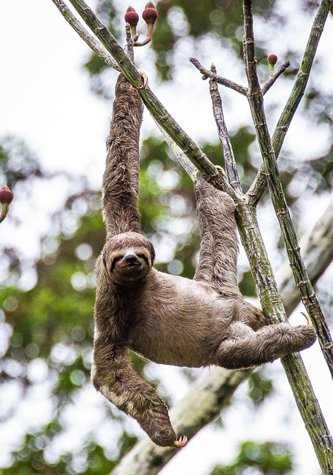This morning we woke up to explore some more by skiff on the Yanalpa Caño of the Amazon River in Peru.
Our three skiffs departed a little earlier in order to explore longer and deeper into the forest. The idea was to take advantage of the best hours of the day, and not to return to the Delfin II until 9:00 a.m. for breakfast.
The scenery and the weather were great this morning on Yanalpa. We got to see the iconic giant Amazon lily pads, and a couple of three-toed sloths hanging at the treetops, stretching in odd uncomfortable-looking yoga-like postures. What an odd animal is the sloth. As we approached the sloths to see them better they very slowly looked down at us, seeming effortless as if to show us how strong and flexible they have adapted to be to life up in the trees.
As we continued navigating during the morning we also ran into two troops of monkeys, the always very active brown capuchin monkeys followed by a troop of squirrel monkeys, several of which curiously poked their head through the vegetation to take a better look at us, and we of them. Just a little later we found up high in a tree a group of three night monkeys that also looked down at us from their balcony through a hole in the tree. What a success—three monkey species in only one morning!
Upon returning to the ship we all headed up for a well-earned delicious breakfast, and to rest a little as we continued traveling downriver to reach the Dorado River for our afternoon outings. As usual as we arrived at the confluence of the main river with the Dorado River, the captain of the Delfin II slowed down and purposely barely kept up navigating until he ran aground the ship on the shallow river’s edge to dock. As we waited for the departure of our afternoon activities, we all took in the interesting scene of the merging of two very different rivers, the main river being brown and full of sediments, and the slower flowing tannin-rich black waters of the Dorado River. The show was enhanced by the pink dolphins actively hunting fish. The confluence of rivers like these is a typical place where dolphins like to hunt for fish. Apparently the fish stall briefly as they suddenly run into a wall of water of a different color and composition, funneling and concentrating the fish briefly and giving the dolphins an advantageous edge to get them.
The afternoon today was quite rainy, but that didn’t stop us from going out for more. There were some great sightings of black collared hawks, wattled jacanas, raucous horned screamers on a nest with eggs, more brown capuchin monkeys, and black and white caimans (also called spectacled). We returned to the ship after dark all very wet, but thrilled after a great day and ready to see what awaits for us tomorrow.







